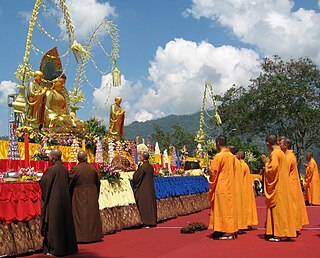
Vesak, also known as Buddha Jayanti, Buddha Purnima and Buddha Day, is a holiday traditionally observed by Buddhists and some Hindus on different days in India, Sri Lanka, Nepal, Tibet, Bangladesh, Bhutan, Indonesia, Philippines, Singapore, Thailand, Cambodia, Laos, Malaysia, Myanmar, Mongolia, and in China, Japan, Korea, Taiwan and Vietnam as "Buddha's Birthday" as well as in other parts of the world. The festival commemorates the birth, enlightenment (Buddhahood), and death (Parinirvāna) of Gautama Buddha in the Theravada or southern tradition.

Won Hyo was one of the leading thinkers, writers and commentators of the Korean Buddhist tradition. Essence-Function, a key concept in East Asian Buddhism and particularly Korean Buddhism, was refined in the syncretic philosophy and world view of Wonhyo.

Korean Buddhism is distinguished from other forms of Buddhism by its attempt to resolve what it sees as inconsistencies in Mahayana Buddhism. Early Korean monks believed that the traditions they received from foreign countries were internally inconsistent. To address this, they developed a new holistic approach to Buddhism. This approach is characteristic of virtually all major Korean thinkers, and has resulted in a distinct variation of Buddhism, which is called Tongbulgyo, a form that sought to harmonize all disputes by Korean scholars. Korean Buddhist thinkers refined their predecessors' ideas into a distinct form.
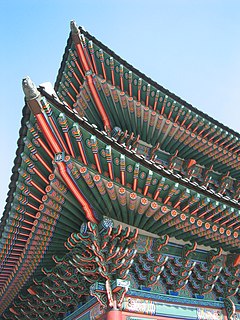
The culture of Korea is the shared cultural and historical heritage of Korea and southern Manchuria. As one of the oldest continuous cultures in the world, Koreans have passed down their traditional narratives in a variety of ways. Since the mid-20th century, Korea has been split between the North and South Korean states, resulting today in a number of cultural differences. Before the Joseon Dynasty, the practice of Korean shamanism was deeply rooted in Korean culture.
Buddhist temples are an important part of the Korean landscape. This article gives a brief overview of Korean Buddhism, then describes some of the more important temples in Korea. Most Korean temples have names ending in -sa, which means "temple" in Sino-Korean.

A bhikkhu is an ordained male monastic ("monk") in Buddhism. Male and female monastics are members of the Buddhist community.

Obon (お盆) or just Bon (盆) is a Japanese Buddhist custom to honor the spirits of one's ancestors. This Buddhist-Confucian custom has evolved into a family reunion holiday during which people return to ancestral family places and visit and clean their ancestors' graves when the spirits of ancestors are supposed to revisit the household altars. It has been celebrated in Japan for more than 500 years and traditionally includes a dance, known as Bon Odori.

Korean arts include traditions in calligraphy, music, painting and pottery, often marked by the use of natural forms, surface decoration and bold colors or sounds.
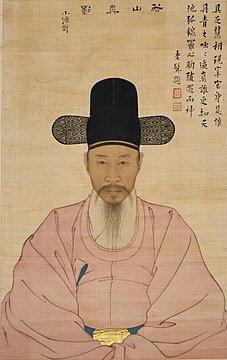
Korean painting includes paintings made in Korea or by overseas Koreans on all surfaces. It includes art as old as the petroglyphs through post-modern conceptual art using transient forms of light. Calligraphy rarely occurs in oil paintings and is dealt with in the brushwork entry, Korean calligraphy. Like arts of East Asia, beauty of space is important for Korean painting.
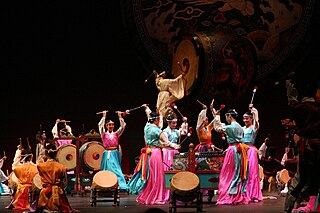
Dance in Korea began with shamanistic early rituals five thousand years ago and now ranges from folk dance to newly created and adopted contemporary dance.

Buchaechum is a traditional form of Korean dance also called a fan dance, usually performed by groups of Korean female dancers.
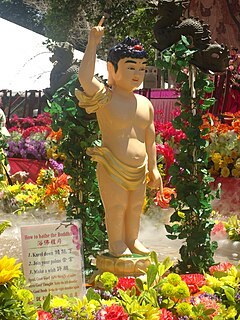
Buddha's birthday is a Buddhist festival and holiday celebrated in most of East Asia commemorating the birth of the Prince Siddhartha Gautama, later the Gautama Buddha and founder of Buddhism. In South and Southeast Asia it is celebrated as Vesak, which places greater emphasis on the enlightenment and death of the Buddha. According to the Theravada Tripitaka scriptures, Gautama was born c. 563–480 BCE in Lumbini in modern-day Nepal, and raised in the Shakya capital of Kapilavastu in the present-day Piprahwa, India, or Tilaurakot, Nepal.

Buddhist art is the artistic practices that are influenced by Buddhism. It includes art media which depict Buddhas, bodhisattvas, and other entities; notable Buddhist figures, both historical and mythical; narrative scenes from the lives of all of these; mandalas and other graphic aids to practice; as well as physical objects associated with Buddhist practice, such as vajras, bells, stupas and Buddhist temple architecture. Buddhist art originated on the Indian subcontinent following the historical life of Siddhartha Gautama, 6th to 5th century BCE, and thereafter evolved by contact with other cultures as it spread throughout Asia and the world.

Bongeunsa is a Buddhist temple located in Samseong-dong, Gangnam-gu in Seoul, South Korea. It was founded in 794 during the reign of King Wonseong by the monk Yeon-hoe (Korean: 연희), then the highest ranking monk of Silla, and originally named Gyeonseongsa. It is located on the slope of Sudo Mountain, across the street from the COEX Mall.

Seungmu is a Korean dance performed by Buddhist monks. It is one of the most famous Korean traditional dances and designated as South Korea's important intangible cultural asset number 27 in 1969. It has been developed into a solo dance by professional dancers.
Barachum is a representative of the Korean Buddhist ritual dance, (jakbeop), and is performed by Buddhist monks with bara (hangul:바라). The term bara describes a cymbal-like Korean instrument made with brass. The dance is composed of splendid and complicated movements among the jakbeop. Performers playing bara repeatedly step back and forth or revolve in agile action. The purpose of barachum is to expel evil spirits and to purify the mind.
Buddhābhiseka refers to a broad range of Buddhist rituals used to consecrate images of the Buddha and other Buddhist figures, such as bodhisattvas.
Seon Buddhism is the name given to the Chan Buddhism tradition in Korea. A main feature of Seon Buddhism is a method of meditation, Ganhwa Seon. A Korean monk, Jinul accepted partially a meditative method of Chan Buddhism in 1205. In Chan Buddhism, hwadu was a delivery of realising a natural state of the Awakening. Jinul addressed a doctrine of Sagyo Yiepseon ) that monks should live an inborn life after learning and forgetting all creeds and theories. Within the doctrine of Jinul, hwadu is the witnessing of truthful meaning in everyday life.
Robert Evans Buswell Jr. is an American academic, author and scholar of Korean Buddhism and Chinese Buddhism as well as Korean religions in general. He is Professor of Buddhist Studies at the University of California, Los Angeles and founding director of the Academy of Buddhist Studies at Dongguk University, Korea's main Buddhist university.
Kim Heung-gook is a South Korean singer. He is the chairman of Korea Singers Association. His daughter, Jenny Kim Ju-hyun participates in Idol School in 2017.













